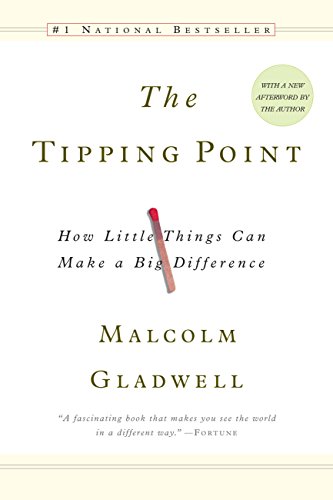

This article is an excerpt from the Shortform summary of "The Tipping Point" by Malcolm Gladwell. Shortform has the world's best summaries of books you should be reading.
Like this article? Sign up for a free trial here .
What is a social epidemic? How does it start? Can social epidemics be useful?
A social epidemic is the spread of ideas, messages, behaviors, and products through a population in the same way that viruses spread. The idea was popularized in the book The Tipping Point, by Malcolm Gladwell.
We’ll cover the requirements of social epidemics and how to create social epidemics to spread your ideas and sell your products.
Social Epidemics: Ideas Spread Like Viruses
You see the phenomenon every flu season: Someone in your office catches a bug, and within a week it seems half her department is infected. In two weeks, there are people showing those same flu symptoms in every department, and by the end of the month half the office has caught the bug.
Each person who catches the virus can infect a whole new set of people, and each of them does the same, in an ongoing ripple effect. The virus continues spreading this way, ultimately creating an epidemic. This is how epidemics grow through geometric progression: When a virus spreads, it doubles, and doubles again, and doubles again, and through that process it grows exponentially.
Ideas, messages, behaviors, and products can spread through a population in a social epidemic in the same way that viruses spread. Epidemics have a few common characteristics.
- Epidemics are contagious. Whether a virus or an idea, it passes quickly and easily from person to person.
- Small changes have big impacts. In the case of a flu going around the office, a change in the strain of the virus could make it last longer, which creates a bigger window of time that people are sick and can spread the germs. Or, something as small as running out of tissues or hand sanitizer in the conference rooms could make a significant difference in the virus’ spread.
- Epidemics don’t build gradually and steadily; they grow and reach a boiling point or critical mass, at which point they explode and turn into an epidemic. That threshold is called the tipping point.
The Three Guidelines for Creating a Social Epidemic
There are three factors that can be adjusted to turn an idea into a social epidemic: the messenger, the message itself, or the context of the message.
- The Law of the Few: Certain types of people are especially effective at spreading an infectious idea, product, or behavior.
- The Stickiness Factor: You can change the presentation of a message to make it more contagious and stickier (having a more lasting impact).
- The Power of Context: The environment in which the message or idea is delivered can have a huge impact on whether enough people adopt and spread it to create an epidemic.
Employing one, two, or all three of these principles can tip a social epidemic.
Use the Right Messengers (The Law of the Few)
When you’re trying to spread a message, idea, or product to social epidemic proportions, you can’t do it all yourself; you need people to help preach your message and spread the word to the masses. But not just anyone will do. The Law of the Few proposes that there are certain, special types of people who are much more effective at broadcasting your idea and getting people to listen and follow suit in order to create an epidemic.
These special people fall into three personality types that make them exceptional either in their social connections, knowledge, or persuasiveness.
Patient Zero of AIDS is an example of the power of key players in the spread of epidemics. This so-called Patient Zero was Gaetan Dugas, who falls into the category of being particularly well connected. Dugas was a French-Canadian flight attendant who reportedly had 2,500 sexual partners across North America. Dugas is linked to at least 40 of the first cases of AIDS in California and New York.
The Law of the Few is a more extreme version of the 80/20 Principle in economics, which dictates that in a given situation, about 20 percent of participants will be responsible for 80 percent of the “work.” For example, 20 percent of drivers cause 80 percent of all traffic accidents. And in many societies, 20 percent of criminals are responsible for 80 percent of crimes.
Make Your Idea Stick (The Stickiness Factor)
Social epidemics tip not only because of the behavior of a handful of key players. A change in the contagiousness and strength of the virus, message, or idea itself can also cause it to tip.
In medical terms, this is when a virus evolves to become more contagious or more infectious. When that happens, people who are infected are less able to fight it off, or stay sick longer, creating more opportunity to infect more people.
- A Dutch AIDS researcher named Jaap Goudsmit traced what he believed to be one of the earliest HIV epidemics to a Dutch hospital ward dedicated to caring for underweight and premature infants. Over the course of three years in the 1950s, 81 infants came down with a form of pneumonia that is closely associated with HIV (which depletes people’s ability to otherwise fight off the illness). Only 24 of the sick infants died, indicating that the HIV virus was less deadly than the form that infected and killed so many people in the 1980s. The virus itself morphed to become more virulent, making it more effective in creating an epidemic.
In social epidemics, this is the factor that makes a message stick or make an impact. In a marketing context, stickiness makes an ad stand out from the white noise of all the media we encounter. (Shortform example: Think of advertisements from 20 or more years ago that still stand out in your head. Maybe it’s the Budweiser “Whassup?” commercial, or (stretching back almost 50 years) the “Mikey Likes It” Life cereal ads.)
To understand the importance of the Stickiness Factor, consider this: If you don’t remember the message, what are the chances you will change your behavior or buy the product? Making an idea sticky and impactful is often a matter of surprisingly small, subtle changes.
Change How the Message is Received (The Power of Context)
Human behavior is greatly affected by the context of our environments. This is key to understanding social epidemics. The Power of Context capitalizes on this insight and suggests altering the context in which people receive your message or idea can make them more receptive to it. This is a little abstract, so let’s take a look at some examples.
On a small scale, you probably behave differently whether you’re with your family, your coworkers, or your old college friends. You’re also likely to act differently in public than you do in the privacy of your home. Is this effect powerful enough to determine whether you follow a fashion trend or join a social movement?
We often don’t realize how profoundly the environment alters how we act. Context changes subconsciously cue us to behave differently — sometimes drastically so — or force us into a new routine that has ripple effects on our actions.
- (Shortform example: Say you take the same route to work every day. One day, the bridge you cross is closed for a construction project that will last three months. You are forced to take another route. This, in and of itself, is a change in behavior. But perhaps this new route is also 15 minutes longer, so you have to set your alarm earlier, or shorten your morning workout, or miss your favorite morning news segment because it comes on at 7:20 and now you have to be out of the house at 7:15. A small change can have many downstream ripple effects.)
Even subtle changes can have a significant effect on how we act. In 1964, a woman named Kitty Genovese was stabbed and killed on a NYC street, despite the fact that there were 38 people witnessinges to the attack. At the time, most reports of the incident blamed witnesses’ inaction on urban callousness. Psychologists later attributed this to the “bystander effect,” which says that when people are in a group, they are less likely to act because they either assume someone else will or assume the problem is less serious because other people are not acting. Genovese, then, would have had a better chance of getting help if she’d been attacked in a more discreet location with just one witness. However, most reports of the incident blamed witnesses’ inaction on urban callousness.
Social Epidemic Example: The Resurgence of Hush Puppies
You don’t necessarily need all three principles to tip a social epidemic — you just need the right ones. The Law of the Few and the Power of Context were both pivotal in launching a sneaker brand called Hush Puppies from the brink of decline to epidemic popularity within the span of a few years.
In the early 1990s, Hush Puppies were selling only about 30,000 pairs a year. Around that time, teens in New York City’s SoHo and the East Village began wearing the sneaker specifically because they were not in style. Fashion Mavens likely contributed to the spread of Hush Puppies in these neighborhoods, noticing the ironically un-trendy trend and alerting friends.
Two fashion designers then noticed the budding trend among those New York City teens, and were inspired to use Hush Puppies to complement their couture. The well-known designers acted as Connectors, broadcasting images of the shoes to a massive audience and tipping the epidemic. What’s more, the fact that they noticed the trend in SoHo and the East Village — two neighborhoods known as centers of cutting-edge, fashion-forward, and experimental styles — illustrates the Power of Context; the effect likely would have been different if the story started with a bunch of Kansas City teenagers wearing the sneaker.
Soon celebrities were wearing the sneaker and Hush Puppies became a mainstream trend. Celebrities and other fashion influencers were Salesmen to the public masses who, just a few years earlier, probably wouldn’t have considered buying un-stylish Hush Puppies. With this potent mix of Mavens, Connectors, and Salesmen, the company sold 430,000 pairs in 1995. Sales quadrupled in 1996, and increased again the following year. This is a great example of a social epidemic.
———End of Preview———

Like what you just read? Read the rest of the world's best summary of "The Tipping Point" at Shortform . Learn the book's critical concepts in 20 minutes or less .
Here's what you'll find in our full Tipping Point summary :
- What makes some movements tip into social epidemics
- The 3 key types of people you need on your side
- How to cause tipping points in business and life






